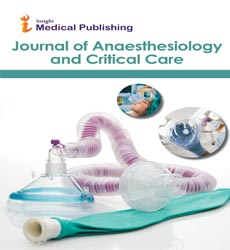Commentary on Patients with Aortic Stenosis
Manuel Lozano J*
Department of Anesthesia and Pain Medicine, Maastricht UMC, Maastricht, the Netherlands
- *Corresponding Author:
- Manuel Lozano J
Department of Anesthesia and Pain Medicine, Maastricht UMC, Maastricht, the Netherlands
E-mail: manuellozano@yahoo.com
Received Date: November 29, 2021; Accepted Date: December 13, 2021; Published Date:December 20, 2021
Citation: Manuel Lozano J (2021) Commentary on Patients with Aortic Stenosis. J Anaesthesiol Crit Car. Vol.4 No.3:15
Aortic stenosis (AS), the most common valvular heart disease in developed countries, affects approximately 12 million people worldwide and contributes to a significant and growing disease burden in the ageing population. Patients with AS are predisposed to perioperative cardiac complications as a result of an aesthetics and surgical stress causing an unfavorable hemodynamic state.
Current guidelines recommend that patients with severe or symptomatic AS undergo surgical or percutaneous interventions prior to elective noncardiac surgery, which is primarily based on studies indicating AS as a major risk factor for mortality and adverse cardiac events after noncardiac surgery; however, the association between AS and perioperative risk has not been well clarified due to conflicting results and study limitations, such as small numbers of AS patients. Furthermore, some previous studies relied on data that is now more than two decades old, making it difficult to reflect recent advances in surgical and an aesthetic techniques for AS patients.
Neuraxial anesthesia has long been considered a contraindication for patients with AS due to its sympatholytic effect, which has the potential to cause precipitous drops in vascular resistance and, as a result, reduced cardiac output and coronary perfusion; however, the concern about neuraxial anesthesia use in AS patients stems from a theoretical risk rather than clinical evidence. There have only been a few case reports describing the use of neuraxial anesthesia in AS patients, and no large-scale study comparing the perioperative risk of AS patients undergoing general or neuraxial anesthesia has been reported. Anesthesia, volatile and intravenous an aesthetics, in general, tends to reduce sinus node automaticity and may result in atrioventricular synchrony loss, arrhythmias, myocardial depression, and heart failure. Furthermore, when compared to regional anesthesia, general anesthesia may increase respiratory complications and 30-day mortality in patients with high cardiac risk.
As a result, we conducted a population-based cohort study to investigate the risk of noncardiac surgery in AS patients. Furthermore, given the paucity of evidence pertaining to safer an aesthetic techniques for AS patients, we compared the risk of adverse outcomes in AS patients using general versus neuraxial anesthesia. Based on previous evidence, we hypothesized that AS is independently associated with higher risks of adverse outcomes, and that general anesthesia carries a higher perioperative risk for AS patients undergoing noncardiac surgery than neuraxial anesthesia.
According to a meta-analysis, the prevalence of all AS and severe AS in patients over the age of 75 is 12.4 percent and 3.4 percent, respectively. 24.4 percent of those with severe AS were asymptomatic. Preoperative echocardiography is recommended for patients with clinically suspected moderate or severe valvular stenosis or regurgitation; however, the need for preoperative echocardiography in patients with high cardiac risk is still debatable. A recent study found that heart failure, defined as a 50% left ventricular ejection fraction, was significantly associated with 90-day mortality after noncardiac surgery regardless of clinical symptoms; however, another study found that preoperative echocardiography was not associated with decreased postoperative complications or in-hospital mortality after hip fracture surgery. To assess the potential benefits of preoperative echocardiography in high-risk patients, randomized trials are required.
Finally, AS was found to be an independent risk factor for inhospital complications and mortality following noncardiac surgery. When compared to neuraxial anesthesia, general anesthesia was associated with more postoperative complications in patients with AS who had noncardiac surgeries. This study emphasizes the importance of anesthesia management in surgical patients with AS and suggests that neuraxial anesthesia is not contraindicated in AS patients. However, due to the retrospective nature of administrative databases and data limitations, this study may be prone to bias. Our findings call for further research in prospective cohorts.
Open Access Journals
- Aquaculture & Veterinary Science
- Chemistry & Chemical Sciences
- Clinical Sciences
- Engineering
- General Science
- Genetics & Molecular Biology
- Health Care & Nursing
- Immunology & Microbiology
- Materials Science
- Mathematics & Physics
- Medical Sciences
- Neurology & Psychiatry
- Oncology & Cancer Science
- Pharmaceutical Sciences
